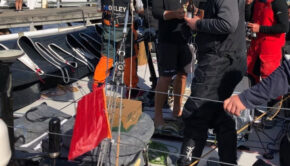Frostbiting Rules To Live By
Published on February 8th, 2016
For those that endure real winters, there are three types of sailors. One type is scanning the Scuttlebutt calendar for any excuse to catch a flight to Florida for short pant sailing. A second type is holding their travel cards and embracing their local frigid frostbite schedule. The third type is on the fence.
For those considering the local scene, or would just like to embrace it more, the SpinSheet magazine shares these tips…
Rule #1: Cotton Kills
Cotton fibers absorb water, are slow to dry, and quickly drain your body of heat when wet. Read labels and stay away from cotton blended fabrics unless they contain less than 15 percent cotton fibers.
Rule #2: Stay Dry
Staying dry means more than just “Don’t Fall In.” Remember, in some racing boats your feet, lower legs, and hands get wet quickly from water entering the cockpit. Your body also gets wet from perspiration during strenuous activity, which can be just as dangerous if you fail to follow Rule #1.
Rule 3: Fashion Does Not Equal Function
Your new jacket may be the latest in trend wear, have a designer label, show your sail number, and match your crew’s outfits, but is it made for the sport? Be careful when shopping, as many brand names carry several lines of clothing which might look similar, but cater to different sports or extremes of environments. For example, some kayaking dry tops, while similar to sailing dry tops, only stay dry when attached to a kayak spray skirt as opposed to being layered over pants. Ask your salesperson the difference between items. Remember: when you wipe out skiing, you don’t (usually) go for a swim.
Rule #4: Wear a PFD (aka Lifejacket)
If you do fall in while frostbiting, or if your boat capsizes, a lifejacket is critical to buoy you in icy, cold water. If you end up in the water and you have followed Rules #1, #2, and #3 but get knocked unconscious, you had better have followed Rule #4.
Proper frostbite attire works as a system composed of three layers:
Layer 1: Wicking (Long Underwear)
Your body sweats to cool down via evaporation of moisture from your skin. The function of the wicking layer is to remove sweat from your skin and transfer it to your other clothing layers before it evaporates. This layer should be made of synthetic fibers, which do not absorb water, wick moisture away from your skin, and dry quickly.
Layer 2: Insulation (Fleece)
This layer is your main defense against the cold. Remember, it is not the material itself that keeps you warm, but the layer of air trapped beneath it. Since bulky clothing generally interferes with sailing a small boat (and with swimming), it is better to rely on several thinner layers that you can add or remove as needed, rather than on a single thick layer. Wool fabrics are warm and stay warm when wet; however, keep in mind they are slower to dry and can get heavy when soaked. Synthetic fleece or poly pile fabrics are best; they stay warm when soaked and are quick to dry.
Layer 3: Shell (Spray Top/Bottom)
The shell layer repels water and keeps the wind from depleting the warm air trapped in your insulation. The shell layer should be loose enough to allow adding additional layers of insulation and should allow for freedom of movement. Look at outerwear with watertight or waterproof gussets or seals at the neck, wrists, waist, and ankles. Ideally this layer should be a waterproof/ breathable material such as Gore-Tex. Remember that the older foul weather gear gets, the less waterproof it stays, and the more likely water will seep through zippers, gussets, seams and fabric. If the gussets and zippers are still good on an older shell, it may be worth re-treating the fabric and seams with Nikwax- or Seamseal-type products.









 We’ll keep your information safe.
We’ll keep your information safe.